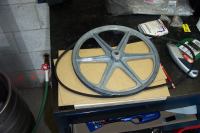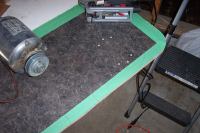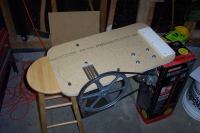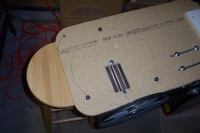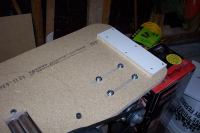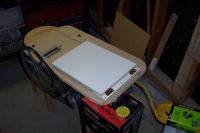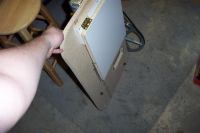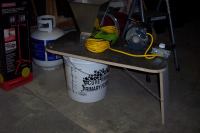bierblog
June 7, 2006
motorizing the barley crusher
if you read my entry about raising the edmund fitzgerald, you know that i've recently purchased a shiny new barley crusher. well, long before i bought it i also had plans to motorize it.
as with all home-made homebrew gadgetry, my first stop is always Mike Dixon's webpage. can't say enough about Mike. he's always active and helpful in the homebrewing forum on beeradvocate, and his webpage has tons of useful info. a quick look down the page and you'll find a page detailing motorizing a malt mill and building a larger hopper for the grain, including a link to an article he wrote in HBD that tells you everything you need to know to motorize a mill, including all the math for getting the right RPM and selecting sheaves and belts. i'm basically just copying info from there, with the numbers changed to reflect the parts i used.
first order of business was a motor. this fall one of my neighbours was getting rid of their furnace, and one of the items that was sitting at the side of the road was a nice electric motor that i knew would work great if it was still functional. it also had a couple of sheaves, and i figured that at least the small one would be useful for my purposes. i stopped at the local hardware store, grabbed a dimmer switch, box, and an extension cord, wired it all up and plugged it in. as i slowly turned on the dimmer switch, the motor began to hum and sprang to life. free motor, excellent!
Grainger is a great resource for all the parts for this project (and lots more). on a recent trip to Minnesota i dropped in to one of their locations and picked up everything i needed for this project.
according to the website, the barleycrusher says it can do 500rpm. my motor is the typical 1725rpm and has a small adjustable sheave is 3.5" with 3.25" pitch diameter maximum and should go much smaller. so with 1725rpm motor and a max of 500rpm on the barleycrusher i know i'd need a sheave pitch diameter ratio of at least:
1725/500 = 3.45
so if we assume that my small sheave is 3.25" that means that the large sheave would need to be:
3.25" x 3.45 = 11.2125" pitch diameter or greater (with existing 3.25" wheel)
so checking out grainger i found a 12" sheave that looked like it'd work. figuring out the exact speed of the mill based on these two sheaves:
12"OD sheave has pitch diameter of 11.85". 1725rpm * 3.25"/11.85" = 473rpm
under 500rpm as expected. great! i also figured out that if i adjust the small sheave so it has a pitch diameter of 2.75" i'll drop the speed even further, to 400rpm. better to be safe, so i figured i'd go for this.
however, the 12" sheaves have an internal diameter of 1/2" and the barley crusher has a shaft that's 3/8". fortunately grainger also has bushings, and the 3/4" to 1/2" bushing would be perfect. the only tricky bit that i had to do was slightly modify the bushing. it's "C" shaped, but the opening wasn't wide enough for me to tighten up the bolt in the 12" sheave. i pulled out my trusty dremel and was able to trim the bushing, widening the opening enough that the bolt to fit through and allowing me to tighten it up on the shaft.
now, to figure out the size of belt i'd need:
center distance of shafts must be > 8"
C = (L - 1.57(D+d))/2
C = (L - 1.57(12+3.5))/2
C = (L - 24.335)/2
C = L/2 - 12.1675
40" length: C = 20 - 12.1675 = 7.8325" (too close)
50" length: C = 25 - 12.1675 = 12.835" (good)
so a 50" belt would be great. again, grainger sells a 50" v belt that would be perfect.
with that i had all the parts i'd need and set to motorizing the mill.
the large sheave and the belt. you can also just barely see the sheave inserted in the center of the sheave.
laying out the pieces and figuring out placement. when we replaced our kitchen countertop recently i saved the piece cut out for the sink. perfect for the base of the mill. another great idea from Mike.
after marking/drilling the placement for the new barley crusher base plate. there's two outer holes to anchor the mill down, and the four corner holes that were used to cut out the exit hole for the grain.
here you can see the barley crusher fitted in place with the sheave attached, and the slots made for anchoring the motor. there's lots of room to move the motor in case i end up switching to a different size belt or need to tighten/loosen it.
the motor, mill, and power all hooked up. now it needs something to sit on for general use.
after flipping over the entire setup i positioned and traced the outline of a bucket. i then took the three bucket gides from the original barley crusher baseplate and transferred them to this one to help hold the bucket in place.
two shots of the underside of the mill. you can see the outline and the position of the guides. i positioned the first one so that it'd also support the leg when closed (more on that below)
the other end of the baseplate. i screwed on a small piece of wood to raise up above the bolts that are holding the motor in place.
then i made a leg so that it'd sit level when the oposite end is resting on a bucket. it's hinged and attached to the piece shown above, and when closed like this the opposite end rests on one of the bucket guide pegs as mentioned above.
standing on its end. notice the chain i added to make sure the leg wouldn't get over-extended.
two shots of the finished motorized mill, one from each side.
so far the motorized version has been used for one brew day. it took us all of 15 minutes to weigh out the grain for the two batches (18# and 16#) and grind it all. that's pretty damn good when you consider that we'd normally be at this for a couple hours of manual grinding with the old corona mill (as seen here).
Posted by grub at June 7, 2006 11:22 PM© 2005 Bierg�tter Homebrew Club. Disclaimer.
Last Modified:
Saturday, 30-Jun-2018 08:44:50 MST
